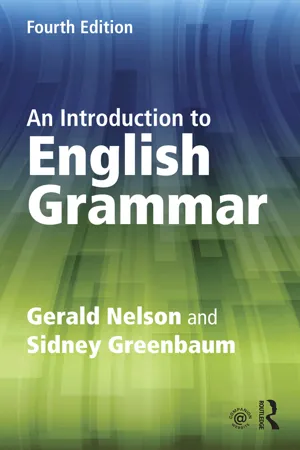
- 350 pages
- English
- ePUB (mobile friendly)
- Available on iOS & Android
An Introduction to English Grammar
About this book
An Introduction to English Grammar provides a comprehensive overview of all aspects of English grammar. The first part of the book ('The Grammar') provides a step-by-step introduction to the key topics in English grammar. The second part ('The Applications') shows how a grasp of these topics can be helpful in resolving usage problems, in developing a clear writing style, and in mastering punctuation and spelling. A whole chapter, 'English in Use', is devoted to illustrating the grammatical features of a wide range of modern text types, including emails, Facebook pages, and 'tweets'. It also looks at the special grammatical features of English in everyday conversation.
Each chapter is followed by two sets of exercises. The first set can be used in self-study or in the classroom. The second set deals with more advanced topics, and can be used for classroom discussion or essay writing.
This fourth edition has been fully revised and updated and includes:
- clearer descriptions and improved presentation
- new material on word structure and word formation
- new exercises, examples and extracts
- updated further reading
Assuming no prior knowledge of English grammar, this book is ideal for beginning students on a one-semester course and provides everything a student needs on the theory and practice of English usage. A comprehensive Glossary of grammatical terms is included and a website provides invaluable additional exercises.
Frequently asked questions
- Essential is ideal for learners and professionals who enjoy exploring a wide range of subjects. Access the Essential Library with 800,000+ trusted titles and best-sellers across business, personal growth, and the humanities. Includes unlimited reading time and Standard Read Aloud voice.
- Complete: Perfect for advanced learners and researchers needing full, unrestricted access. Unlock 1.4M+ books across hundreds of subjects, including academic and specialized titles. The Complete Plan also includes advanced features like Premium Read Aloud and Research Assistant.
Please note we cannot support devices running on iOS 13 and Android 7 or earlier. Learn more about using the app.
Information
Part I
The grammar
1
The parts of a simple sentence
1.1 How we analyse sentences: form and function
- [1] A heavy snowfall has blocked the mountain passes.
- [1a] *Has blocked the mountain passes a heavy snowfall.
- [1] A heavy snowfall has blocked the mountain passes.
- [2] They encountered a heavy snowfall.
- [3] The mountain passes are now open.
1.2 Subject, predicate, verb
| subject | predicate |
| I | learned all this much later. |
| The chef | is a young man with broad experience of the world. |
| The earthquake | measured 6.8 on the Richter scale. |
1.3 Operator
Table of contents
- Cover
- Title
- Copyright
- Dedication
- Contents
- Preface to the fourth edition
- Introduction
- PART I The grammar
- PART II The applications
- Glossary
- Further reading
- Index